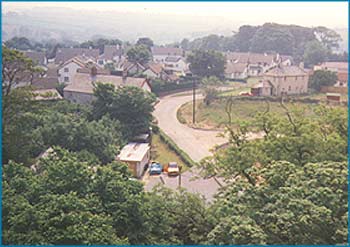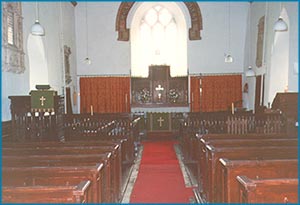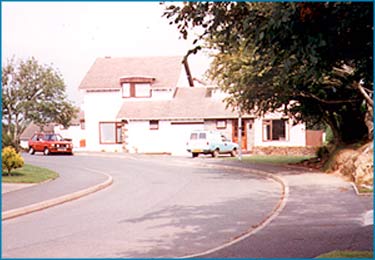Bradworthy is a very old village which, it used to be said was noted for its Square and its horniwinks. The Square, the towne-place as it is described in old deeds, largest village square in the Westcountry, will no doubt remain the centre of the village as it has for over a thousand years; but for the horniwinks - a local name for peewits - which would have haunted the Moors for thousands of years, for some unknown reason have gone.

Leaving the village on the Holsworthy road
Here we have one of the best examples of a Saxon village in the Westcountry. Founded shortly after the Saxon conquest of North Devon, probably about 700 AD. Facilities include a pub, church, post office, general stores, butchers, tea rooms and doctors.
Bradworthy was the centre of an extensive territory including what is now the parish of Pancrasweek. The Square was once a grassy green described by Miss M. P. Willcocks, the novelist, as being as full of the romance of the past as the magic phrase 'the Great North Road'. It is not now, though, quite such a place of old-world peace as she described. But Bradworthy still has a grassy green known as the Broad Hill in the Lower Village, planted with copper beech and flowering cherry. Of the houses in the village the old part of the Inn is of an early date and might have been the old Church House.
It is remarkable that there are, in addition to Bradworthy itself, seven other farms within the present parish which were Saxon manors recorded in the Domesday Book.

The interior of St. Johns Church
The Bradworthy manor was for centuries owned by distant lords, first the Devon noblemen, the Pomerais and William, Lord Brewer, then the Mohuns (of Somerset) and later the north country family of Stanley, Earls of Derby.
There was no resident lord of the manor until what remained of it was purchased by the Ashton family early in the 19th century.
The church, dedicated to St. John the Baptist, has a fine well-proportioned tower, embattled with pinnacles erected about the year 1500. The interior of the church is plain. It did not, like many churches, come in for major reconstruction and enlargement in the 15th and 16th centuries, so there are several features showing its stages of growth. The font is all that remains of the Norman church, which was extended in the 13th century to make what was probably a cruciform church. Of this Early English period there are two windows in the chancel, the arch to the south transept and a piscina of unusual design. Extensively damaged by a fire in 1395, the re-built church was re-dedicated in 1400.

Ford Crescent
Note the great roof arches of oak beams supporting the unusually broad nave. In the flooring are a number of ancient encaustic tiles, common in many churches in this area. They were probably laid about the middle of the 16th century and bear some interesting designs such as the Tudor rose, lion rampant, fleur-de-lys and Pelican-in-her-piety. The village stocks are preserved here.
A fire in the 18th century is thought to have destroyed much of interest, including carved bench ends. The only old carving surviving today is in the pulpit, stated to be Jacobean, but possibly older. Tradition claims that Cromwell's soldiers tied up their horses in the church, which could have accounted for the destruction of some early fittings and furnishings.
In the churchyard is a small headstone in memory of John Cann, who according to the inscription went through all the Peninsular War and was at Waterloo. He died in the village at the age of 101.
During the last century there was a large migration of people from Bradworthy to the colonies, and several of them became prominent in political and public spheres in North America, Australia and New Zealand.
On the south west side of the parish are the Tamar Lakes in pleasant rural surroundings. The valley is a bird sanctuary and anglers find good fishing there. The Torridge flows south eastward and beneath Kesmeldon Bridge where tradition says the first pipe of tobacco was smoked by a mariner who was in Raleigh's first expedition to Virginia. We are in the Putfords and entering an area of countryside as peaceful and unspoilt as any.
Extract from the writings of local historian Cecil Collacott
Back to top
Show me the
Bradworthy
Home Page